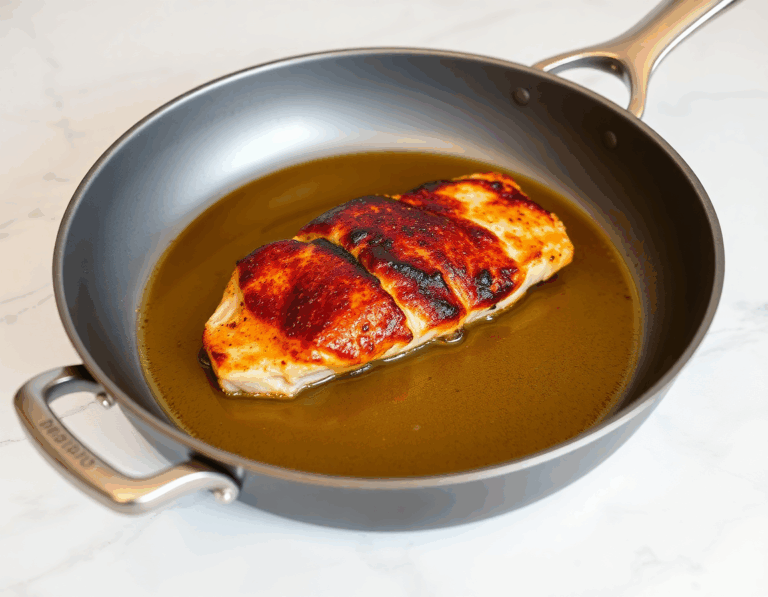
Ah, pork tenderloin—the unsung hero of quick yet impressive dinners! There’s something utterly magical about transforming this humble cut into a succulent, flavor-packed feast.
Picture this: a chilly evening, the aroma of herbs and spices dancing through the air, and a tender, juicy roast that practically melts in your mouth.
Whether you’re hosting a gathering or simply craving comfort food, this recipe is your ticket to culinary bliss.
Steps
- Begin by preheating your oven to 400°F, placing the rack in the center. Trim any excess fat or silver skin from the pork tenderloin using a sharp knife, and pat the meat dry with a paper towel.
- In a small bowl, mix sea salt, freshly ground black pepper, Italian seasoning, garlic powder, and ground coriander to create your dry rub.
- Pierce the pork tenderloin all over with a fork, then coat it with 1 tablespoon of oil. Sprinkle the dry rub onto the meat, using your hands to ensure it is evenly covered with the spices.
- Heat 1 tablespoon of oil in a large oven-safe pan over medium-high heat. Once hot, add the pork tenderloin and sear it on all sides for about 6 minutes to develop a golden crust.
- Transfer the pan to the oven and bake the tenderloin uncovered for 13-15 minutes, flipping it halfway through. Ensure the internal temperature reaches at least 150°F, then let it rest on a cutting board for 5-10 minutes.
- After resting, slice the pork into medallions and serve immediately. Enjoy your flavorful and juicy roasted pork tenderloin.

Ingredients
- 1 1/2 pounds pork tenderloin
- 1 teaspoon sea salt (or to taste)
- 1/2 teaspoon freshly ground black pepper
- 1 teaspoon Italian seasoning
- 1 teaspoon garlic powder
- 1 teaspoon ground coriander
- 2 tablespoons extra light olive oil (or vegetable oil or avocado oil)
Nutritional Values
Calories: 1084 kcal | Carbs: 4 g | Protein: 140 g | Fat: 52 g | Saturated Fat: 12 g | Polyunsaturated Fat: 8 g | Monounsaturated Fat: 28 g | Trans Fat: 0.4 g | Cholesterol: 444 mg | Sodium: 2684 mg | Potassium: 2752 mg | Fiber: 1.2 g | Sugar: 0.16 g | Vitamin A: 60 IU | Vitamin C: 0.8 mg | Calcium: 84 mg | Iron: 8 mg
FAQ
- What is the difference between pork tenderloin and pork loin?
- Pork tenderloin and pork loin are both lean but differ in size and shape. Pork tenderloin is smaller and thinner, usually weighing between 1 to 1.5 pounds, whereas pork loin is larger and can weigh between 2 to 5 pounds. They are not interchangeable in recipes due to these differences.
- Can I marinate pork tenderloin for this recipe?
- Marinating is not necessary for this recipe. Piercing the tenderloin with a fork allows the seasoning to penetrate deeply, eliminating the need for marinating. This makes it a quick option for preparing flavorful pork.
- What is the ideal internal temperature for cooked pork tenderloin?
- The USDA recommends cooking pork tenderloin to an internal temperature of 145°F, followed by a rest period of at least 3 minutes. At this temperature, the meat will appear slightly pink in the center, which is normal and safe.
- How do I store leftover roasted pork tenderloin?
- Allow the pork to cool to room temperature before storing it in an airtight container or wrapping it tightly in aluminum foil. It can be refrigerated for up to 3-4 days. For longer storage, you can freeze it for 2-3 months by wrapping it in plastic wrap and placing it in a freezer-safe container.
- What sides pair well with roasted pork tenderloin?
- Pork tenderloin has a mild flavor that pairs well with a variety of sides. Some popular options include roasted or mashed potatoes, green beans, broccoli, and salads like Caesar or arugula beet salad. Rice dishes like risotto or cilantro lime rice also complement it well.
Tips
- Properly Prepare the Tenderloin: Before seasoning, ensure you remove the silver skin by sliding a knife between it and the meat while pulling it away. This step helps the seasoning penetrate better and prevents chewy bites.
- Pierce for Flavor: Use a fork to pierce the pork tenderloin all over. This allows the seasoning to seep deeper into the meat, enhancing the flavor without needing a marinade.
- Use an Oven-Safe Pan for Searing: Choose a pan that can easily transition from stovetop to oven, like a cast iron skillet or Dutch oven. This allows you to sear the pork and then bake it without transferring it to another dish, saving time and preserving flavor.
- Monitor Internal Temperature: Use an instant-read thermometer to ensure the pork reaches at least 150°F in the center. Letting it rest after cooking helps retain juices, making the meat tender and juicy.
Equipment
- Instant-read thermometer – This is crucial for checking the internal temperature of the pork to ensure it is cooked to perfection.
- Cast iron pan or Dutch oven – Essential for searing the pork and oven-safe for baking.
- Sharp knife – Needed for trimming the pork tenderloin and removing the silver skin efficiently.